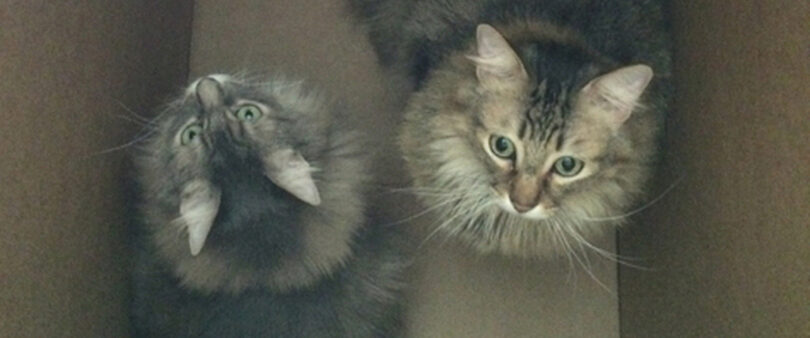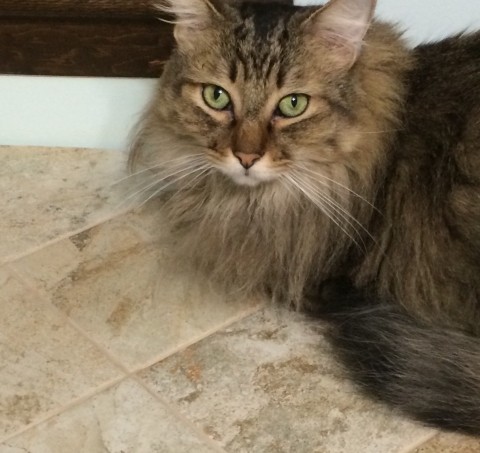A friend recently asked me if I know how to train cats to wear collars, because she’s having problems getting her cat to leave her collar alone. I gave her the usual advice, such as making sure the collar was tight enough that her cat couldn’t pull out of it, but loose enough that she could still get a finger underneath it, and other such advice. Her question piqued my interest, though, because our cats don’t wear collars (yet), so I don’t have a lot of experience in how to train cats to wear collars.
We actually need to train our cats to wear collars, because we have two that like to try and get outside. Chase has actually succeeded in bolting out the back door. Fortunately, he was overwhelmed by the wonder of actually being outside, and stopped in the middle of the yard to look around and sniff the air. I was able to get him to come to me, and I carried him back inside.
He hasn’t tried it again since, probably because we’ve been extremely careful about making sure he can’t get past us when we open the door. There’s always the possibility that he’ll manage to do it again, though. He could then head for the driveway and the street, or worse, the hole in the back fence. All of our cats are microchipped, but they don’t wear collars at all. If Chase did manage to get away, without a collar and ID tag, someone might see him and decide to take him in, without ever finding out if he belongs to someone else.
All cats should wear collars, even if they’re indoor-only
It might seem a little silly to put collars on cats, especially if they’re indoor-only cats. However, a combination of ID tags and microchips are your cat’s best bet for getting home safely and quickly if he ever gets out. Thus, it’s always a good idea to train cats to wear collars, even if they’re indoor-only cats.
You’ll want to buy a breakaway collar, because even if it fits perfectly, and your cat has learned to forget about it, he can still get it caught on things inside. The last thing you want is for something terrible to happen to him while you’re at work, or asleep, because his collar was caught and he couldn’t get out of it.
The best way to train cats to wear collars
The first thing to do is put the collar on your cat only when you can supervise him. This way, you can monitor him for excessive scratching or pulling, and remove the collar quickly if something happens. You can take the collar off when you go to bed, or to work, as he gets used to it.
World of Animal Welfare (WOAW) advises choosing a time when your cat is calm, and preferably happy, to introduce him to his collar. You’re putting something around his neck, which is his most vulnerable spot, so he’s not likely to be happy about it. Trying to train cats to wear collars when they’re already stressed is an exercise in futility – you’ll never be able to do it.
The American Humane Association says that one of the best ways to train cats to wear collars involves positive reinforcement and distraction. Put the collar on him, and then give him one of his favorite treats. You can also distract him with a little playtime, or perhaps even mealtime. This helps to teach him that he can still do everything he enjoys, even though he’s got a foreign object around his neck.
WOAW also says that, for the first few weeks, your cat might become quite skilled at slipping the collar off. Whenever that happens, simply put the collar back on, and reward him with more treats, scritches, and playtime. Keep trying to distract him from the feeling of the collar. Fun distraction may prove to be your best resource when you’re trying to train cats to wear collars.
Finally, patience is always the key. It can take awhile to train cats to wear collars without pulling them off. Never yell at him, or punish him, for finding a way out of his collar, because he either won’t know what you’re punishing him for, or it’ll give him a bad association with the collar and you’ll never be able to train him to wear one.






My indoor-outdoor cat loses hers when she goes off. I’ve actually had a neighbor bring it back to me, only to have her lise it again. I’ll put the next one on tighter.
That must be frustrating. When you put the next one on, be sure you can still get a finger under it without choking her so you know it’s not too tight to be safe.
My cats will pout and hide in boxes or under blankets when they have a collor on
Awwwww…poor babies. Sometimes it takes a lot of time, patience, love, and treats. There’s every possibility that some cats will just never take to collars, too, though.